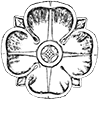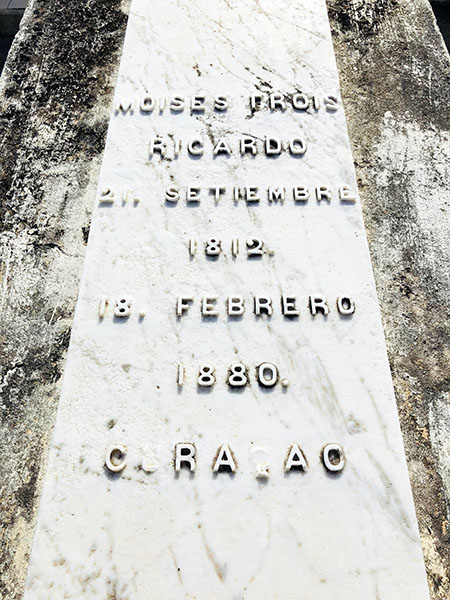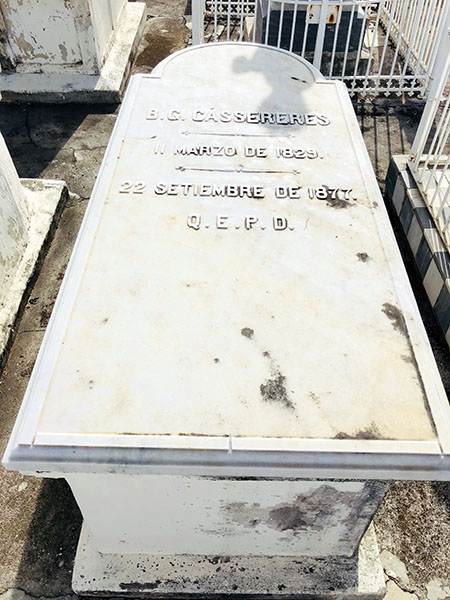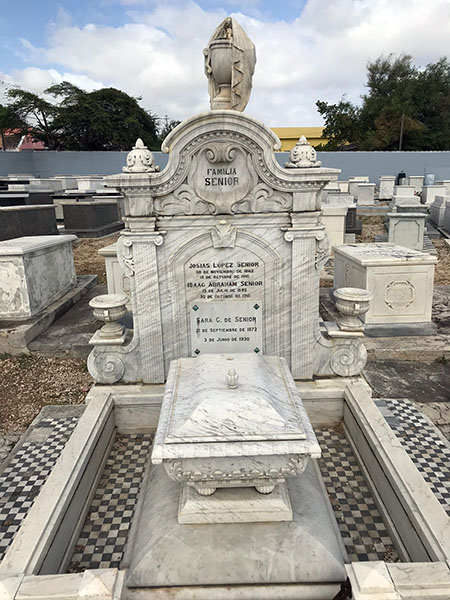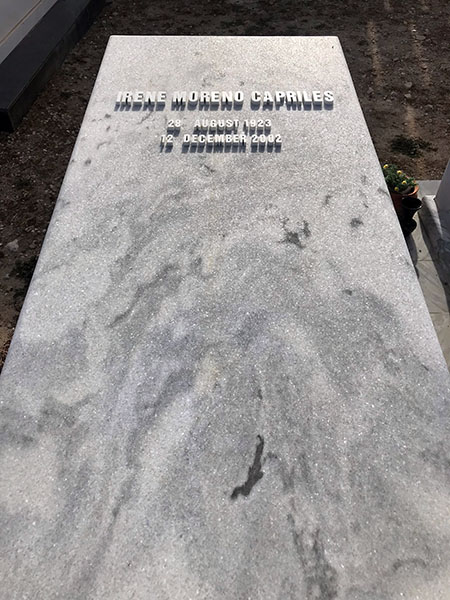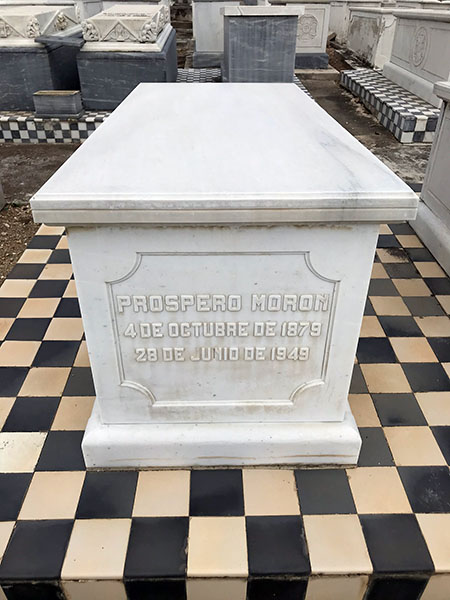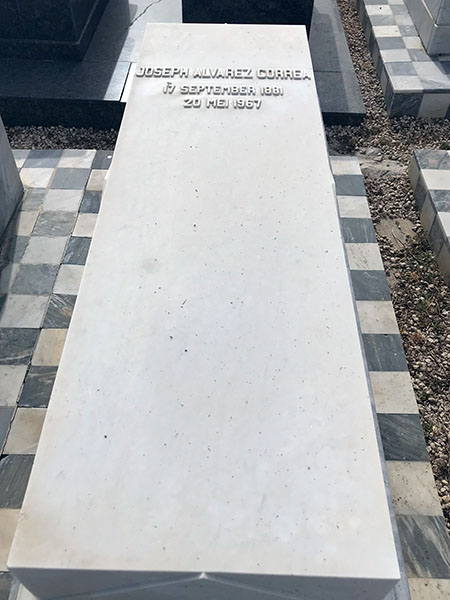beth haim berg altena
Virtual tour of selected tombstones
- 01. Dr. Julius Benesch
- 02. Julius Lopez Penha
- 03. Rebecca Cohen Henriquez
- 04. Sol. Cohen Henriquez
- 05. Jacob Jeosuah Naar
- 06. Manases Capriles
- 07. Moises Frois Ricardo
- 08. B. G. Cássereres
- 09. Familia Senior
- 10. Irene Moreno
- 11. Charles Gomes Casseres
- 12. Dr. Salomon de Leon
- 13. Dr. David Ricardo Capriles
- 14. Serafina Henriquez Morón
- 15. Abraham Mendes Chumaceiro
- 16. Joshua (Jossy) M. L. Maduro
- 17. Salomon Elias Levy Maduro
- 18. Ena Dankmeijer-Maduro
- 19. David Haim Salas
- 20. Otto Senior
- 21. Dr. Salomon Mozes Lansberg
- 22. Jozef da Costa Gomez
- 23. Prospero Moron
- 24. Lionel “Paps” Capriles
- 25. Joseph Alvarez Correa
After World War I, Dr. Julius Benesch, who had been born in Austria, decided to leave his place of birth. Exactly how he ended up in Curaçao is not clear, but from 1922 to 1925 he was a government physician on the island. Subsequently he was off island for about a decade and returned in 1938 to open a private medical practice as a general practitioner. When the Netherlands were invaded by Germany on May 10, 1940, the colonial government on the Dutch islands ordered all German and Austrian citizens to be detained and deported to an internment camp on the island of Bonaire. This included Germans and Austrians of the Jewish faith. And so Dr. Benesch and his wife Mela, as well as other members of the Ashkenazi community, including the well-known photographer Fred Fischer (MM-18), found themselves living in close quarters on the neighboring island with several sympathizers of the Hitler regime. An untenable situation! Later that year the interned Jews were placed on a separate plantation in Bonaire. Only through the help of Rabbi Isaac Jessurun Cardozo of Curaçao’s Mikvé Israel community, who brought this absurd action to light by writing to international organizations such as the American Jewish Joint Distribution Committee and the World Jewish Congress, were the Jewish interns finally released. But they were required to report daily and subjected to a curfew. It was not until March 1944 that the restrictions imposed on these Austrian and German Jews were repealed. Yet, Dr. Benesch and many of the others who had been detained returned to Curaçao. Here Dr. Benesch built a successful medical practice and was the trusted general practitioner (“huisdokter”) of Jews and non-Jews alike.
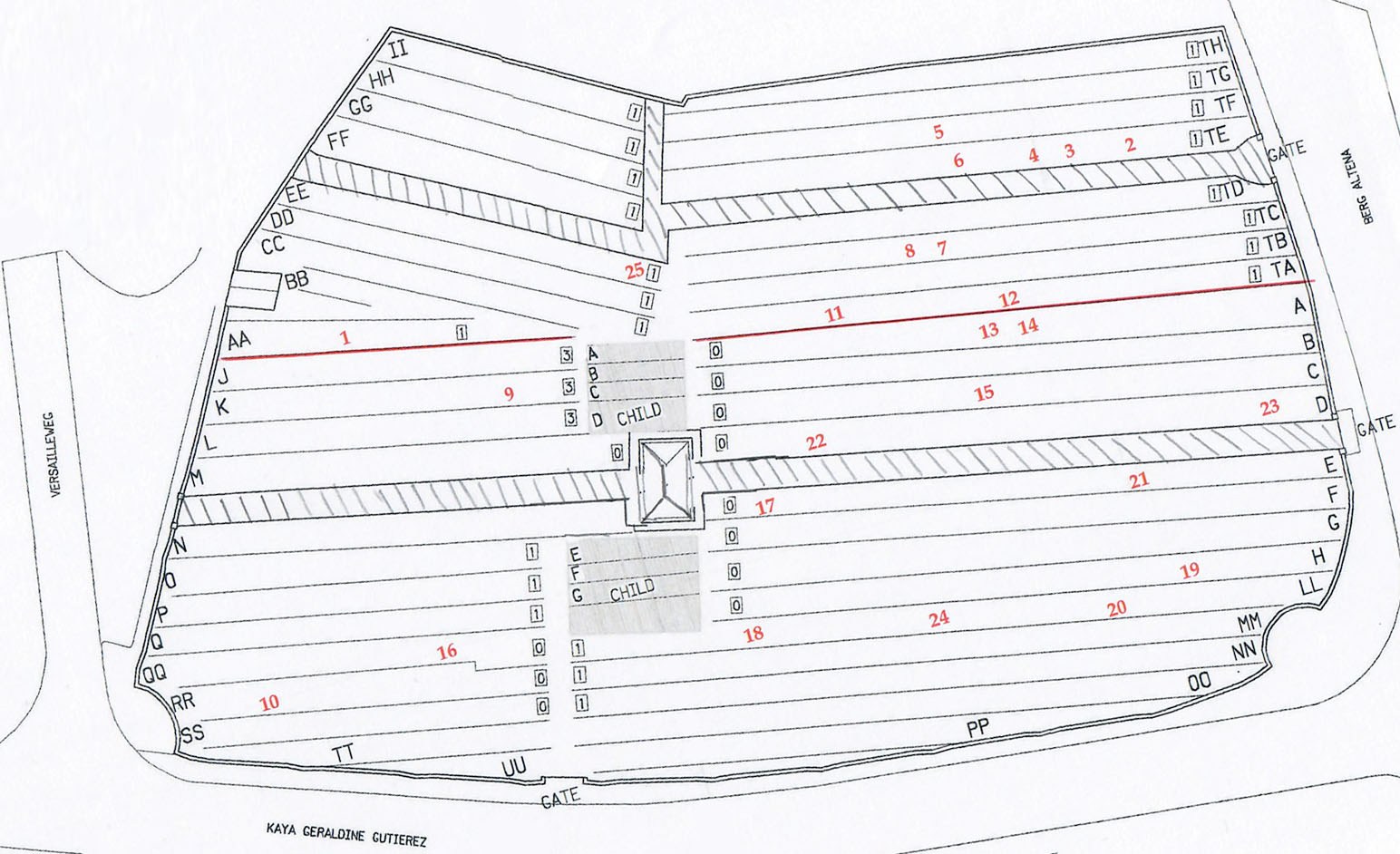
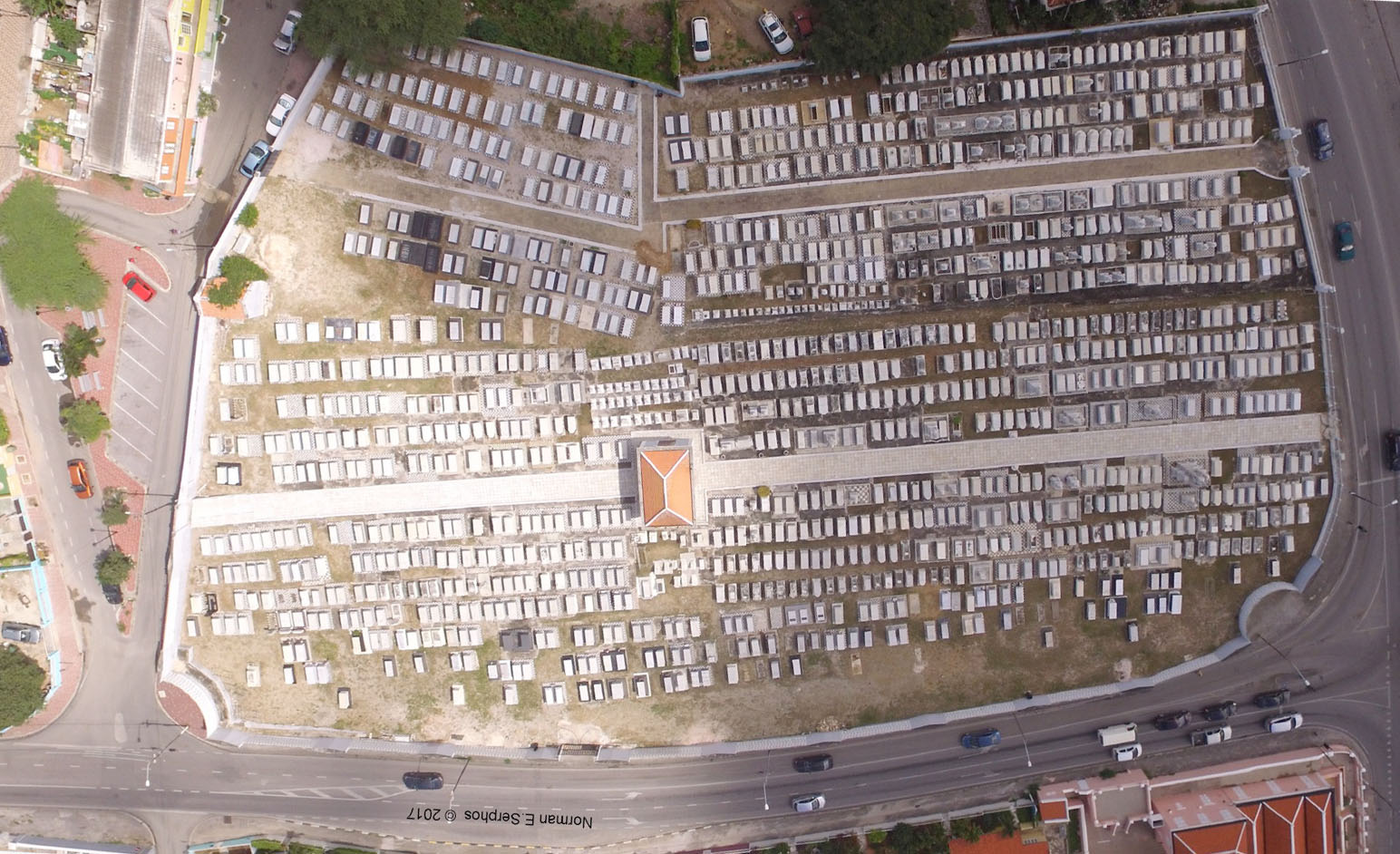
Tombstone Location: AA-16
Julius Lopez Penha was born in St. Thomas, Virgin Islands, where his Curaçoan parents lived for a while when that island’s economy was on the upswing. In Curaçao, he became known as an erudite man, who later in life owned a huge library which was open to his friends and their offspring. He experimented with the culture of European fruit trees and cattle-raising on his plantations. He married Esther Naar, daughter of the wealthy Jacob J. Naar and eventually ran the business known today as J.L. Penha and Sons. That business is still owned and managed by his descendants and located in the iconic Penha building built in 1708 in downtown Punda for the then governor of Curaçao, right at the foot of the famous floating Emma Bridge at the harbor’s entrance. The epitaph includes the letters GR, three dots arranged in a triangle, and the number 33. This reflects that he had been bestowed the honorary 33rd Masonic Degree for meritorious service to craft masonry.


Tombstone Location: TE-6
Rebecca Cohen Henriquez was, as stated on her tombstone, knighted by Queen Wilhelmina of the Netherlands and honored with the decoration of Officer in the order of Simon Bolivar by Venezuela for founding and serving as president of Club Entre Nous. The Club Entre Nous was a benevolent society that raised most of its funds by giving theatrical performances. These monies were used to establish the Wilhelmina Park in downtown Punda and to distribute food packages to needy families in Curaçao. Rebecca’s tomb is one of a row of seven similar tombs of the Cohen Henriquez family.


Tombstone Location: TE-13
Sol. Cohen Henriquez was attorney general of Curaçao for many years and second in rank to the governor. During an absence from Curaçao by the governor in 1890, he served as acting governor. He was decorated with the highest orders extended to civilians in the Kingdom of the Netherlands: Commander of the order of Oranje Nassau and Officer of the Nederlandse Leeuw. Sol Cohen Henriquez was instrumental in the establishment of the Reform Temple Emanu-El and helped draw up its constitution. He was the father of the energetic and charitable Rebecca Cohen Henriquez (TE-13), who is buried nearby and whose tombstone mimics her father’s in style.


Tombstone Location: TE-16
This imposing tombstone belongs to Jacob Jeosuah Naar. As indicated in the Dutch text on this tombstone, Naar was Commander of the National Guard in Curaçao. The sword, hat and epaulettes worn by the Commander are depicted on this elaborate structure. Jacob J. Naar was a wealthy man who married an even wealthier woman, Abigail Cohen Henriquez. Abigail had brought a dowry of close to 48,000 florins to the marriage and they had seven children. Naar owned four large plantations as well as a very profitable snuff factory. Upon his death, the family displayed their wealth and love for the deceased by honoring him with this most impressive monument which adjoins several other elaborately sculpted tombs of his wife’s Cohen Henriquez family. Note that these Cohen Henriquez’, similar to the tombs of Sol and Rebecca, are also of similar design and ornaments, while the immediate family is grouped together.


Tombstone Location: Tf-22
This unusual tombstone with a bust of Manases Capriles stands out even in this cemetery with its many sculptures. It is the only one that has a depiction of the deceased and was sculpted in 1895 in Genoa, Italy. Manases Capriles had migrated from Curaçao to Coro, Venezuela as a young man and was an entrepreneur. He became involved in the manufacture of soap, and later also produced hides, candles, and castor oil. Eventually he sold his manufacturing concerns and invested in the short-lived Coro – La Vela Railroad, hoping it would increase business for the region. Although he died in Coro, his remains were brought back to his island of birth to be buried here. He is one of the few members of the Capriles family to secede from Mikvé Israel at the time of the schism and as such was interred in the area that was Temple Emanu-El’s burial ground.


Tombstone Location: TE-21
Moises Frois Ricardo was the itinerant mohel (circumciser) of the Caribbean. He left behind a journal of one hundred ninety-nine (199) circumcisions performed in Curaçao, Jamaica, Dominican Republic, Venezuela, and Colombia from 1840 to 1878. He was a member of the National Guard in Curaçao and had to request permission to leave the island each time his circumcision services were required in other parts of the Caribbean. He retired in 1860 with the rank of Captain but continued to perform the circumcision rites for many years thereafter. Frois Ricardo was a religious and learned man and took his responsibilities very seriously. He was the son of Mordechay Ricardo, who in 1814 had housed the sisters of Simon Bolivar in his mother-in-law’s country home called Octagon. The Octagon building, situated at the back of the Avila Beach Hotel, now has a museum recalling this gesture of friendship. Ricardo’s grave is unique as the epitaph is on a rectangular slab of concrete placed on top of the usual tomb.


Tombstone Location: Tc-24
This tombstone of Benjamin Gomes Cásseres, one of Ten Gomes Casseres Brothers, serves to show that sometimes mistakes were made even on these expensive marble slabs which were usually ordered from overseas. As can be seen, the name was spelled Cássereres instead of Cásseres. One must assume that it would have been too difficult to return this tombstone and request another one, and apparently nobody in Curaçao was able to remove the extra letters and fix this memorial to Benjamin Gomes Cásseres.


Tombstone Location: Tc-26
In addition to being a large and elaborate structure erected over the remains of several members of the Senior family, this tombstone is a lesson in the history of Curaçao’s Sephardim. After Venezuelan independence, Jews were welcomed to settle in that turbulent country. Among the early Curaçaoan Jews to try their fortune in Coro, Venezuela were members of the Senior family. Josias Lopez Senior (1862-1918,) who heads the list of names shown on this tombstone, was the grandson of one of these original immigrants to Coro. The Seniors managed to have great success in business in Venezuela, and from a young age Josias ran the firm “Isaac Senior e Hijos” that was started by his father. Interestingly, Curaçao remained the home of these Seniors up to three generations after the first member of the family settled in Coro. Even when they would die away from the island, their remains were brought back to the mother community. And so Josias, who died in Switzerland, his wife Sara who died in Coro, and their son Isaac (Ivan) who died in England were all buried in Curaçao’s Berg Altena cemetery, as were Josias’s father and grandfather. Coro was their business home – Curaçao was the home of their souls.


Tombstone Location: k-5,6,7
Irene Moreno spent much of her life organizing events of various kinds, raising money for the less fortunate, and inspiring others to do the same. She married Ivan Moreno in her early twenties and they had four children. But raising them was not the only thing Irene was to do. At the Curaçaosche Sports Club (CSC), founded by her father, she ran sports events, coached basketball teams, arranged ping-pong tournaments, and served on the board of the Club. Beyond those club activities, she sang in the synagogue choir, raised funds for the Curaçao Lions Club and many other foundations, and founded a Home for the Elderly. One could be sure to be sold a lottery ticket or be solicited for a donation for one of her favorite charities on many occasions – and she would never take no for an answer. In these ways, she greatly enriched the Jewish community and the community at large. In recognition of all Irene Moreno had meant for the Curaçao society, she was knighted by Queen Beatrix of the Netherlands.


Tombstone Location: RR-20
The inscription on this tombstone “Honored in Life – Remembered with Tender Love” is most appropriate for this self-made man who was born in Cuba where his Curaçaoan parents participated in the sugar boom of the early part of the twentieth century. Charlie, as he was known, came to Curaçao only eight years of age when his parents left Cuba, completed his schooling here, and proceeded to work, first in the family retail store, then at the firm of Edwards Henriquez & Co, and ending his business career at Maduro & Curiel’s Bank. He served as president of Temple Emanu-El, Mikvé Israel-Emanuel and the Jewish Cultural Historical Museum as well as on the boards of many business and social organizations and semi-public entities. Within the Jewish community, he remains best known as the knowledgeable historian of Curaçao’s Sephardim with many articles to his name. Together with Otto Senior (LL-45) and Rabbi Simeon J. Maslin, he was also a motor behind the merger of the two Sephardic congregations in Curaçao. Additionally, he published two books in Dutch, entitled “Bewoond Scharloo” and “Punda, Punda,” in which he recalled in charming detail life in Curaçao in the 1930s and 1940s. He was honored by the Royal House of the Netherlands with the distinguished orders of Officier Oranje Nassau and Ridder Nederlandse Leeuw, awarded the Silver Carnation of the Prins Bernhard Cultuur Fonds and also received many commendations from numerous other organizations in which he played an instrumental role.


Tombstone Location: ta-61
These two pillars mark the burial places of Dr. Salomon de Leon and his wife Sarah. Dr. De Leon was (one of) the first person(s) to be buried in the Berg Altena cemetery. His tombstone and those immediately around it are the oldest ones in this burial plot. His wife Sarah survived him by 35 years. When the doctor passed away at the young age of 41, she enlisted the help of her wealthy and learned brother, Anjel Jesurun, to raise their only son, Daniel, who was a mere 12 years old when his father died. After studying in Hildesheim, Germany, Daniel settled in New York City. By 1890, he had become one of the leading figures in the socialist movement and industrial unionism in the USA. This was probably not quite what Uncle Anjel had had in mind for him, yet he excelled in his field and was considered a charismatic leader and brilliant speaker for early socialist causes in America.
Note: Next to this first burial place in the new Reform Emanu-El cemetery, there is a column marking the grave of a M.P. Brandao mentions a date of death of 1860, appearing thus to be five years before this “first burial”. Based on information available of M.P. Brandao’s family, however, it is most likely that he lived and passed away in Colombia, and that after an initial interment there, his remains had been brought to Curaçao to be buried in the island of his forefathers.


Tombstone Location: ta-33
1837-1902
Dr. David Ricardo Capriles
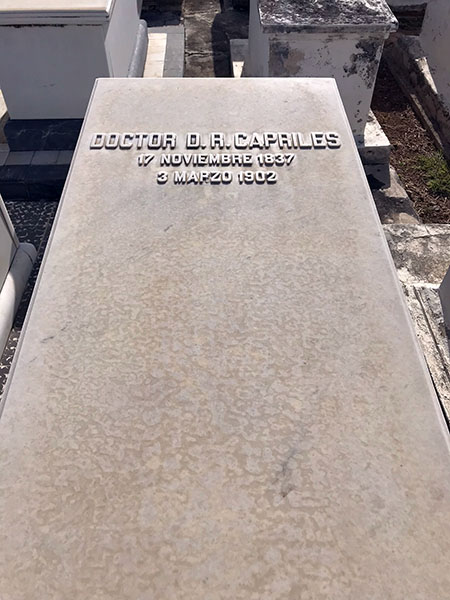
Dr. Capriles received his medical degree from Columbia University in New York at age 20 and returned to Curaçao to practice medicine in 1858. He wrote a seminal paper about the high incidence of mental illness in Curaçao due to advanced levels of syphilis among the poor and correlated the disease directly with the unsanitary living conditions that existed at the time, chastising the Dutch colonial government for allowing so many to live in the squalor that promoted the spread of this disease.
Capriles was a multitalented man who wrote poetry, skits, and more serious texts, expressing himself fluently in Papiamentu, English, Spanish, Dutch, and French. For years, he opened his home to musical and theatrical performances, offering well-attended soirees that were referred to as “Salon Capriles.”


Tombstone Location: ta-23
One of seven siblings, this young girl died at the tender age of twelve and was immortalized with this beautiful and unusual monument. Note on the back side of the grave a marble plaque with chopped off tree branch, unable to reach its full growth, reflecting her premature death. Most young children were buried in less elaborate, small plots as seen on both sides of the Casa de Rodeo and near the walls of the erstwhile Reform section of the cemetery.


Tombstone Location: a-25
Abraham Mendes Chumaceiro was a lawyer who cared deeply for the people of Curaçao. He became quite well known in his profession and even more so for his activist writings. In one of his most progressive essays, he expressed the desire for universal suffrage, opposing those who believed that the population of African descent was inferior and should not be given the vote. His eloquent article on this topic was provocatively entitled “Zal het kiesrecht Curaçao tot het Kannibalisme Voeren” (“Will universal suffrage lead Curaçao to Cannibalism?”.) Also, his book “Is Curaçao te Koop” (“Is Curaçao for Sale”?”), written in response to growing Dutch discontent with its colony and a clear interest on the part of Venezuela to take over the island, was widely lauded. At his tomb there is a special plaque which attests of the honor bestowed to him posthumously in 1938 by the first democratically elected parliament of the Dutch Antillean islands for all he had done to promote the cause of universal suffrage.


Tombstone Location: c-22
1881-1964
Joshua (Jossy) M. L. Maduro
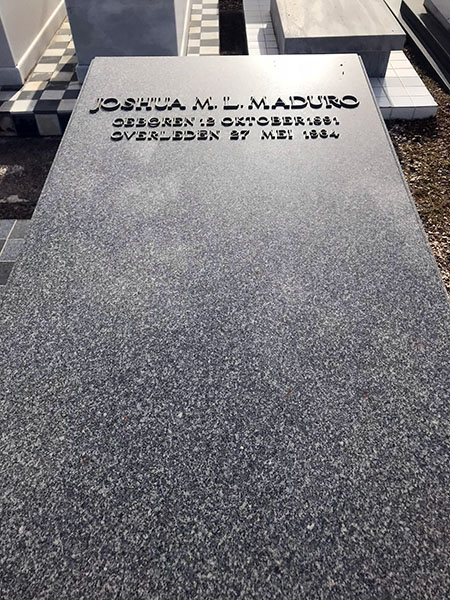
Joshua M.L. Maduro (or Jossy as he was more commonly called) was a grandson of the founder of S.E.L. Maduro & Sons, Salomon Elias Levy Maduro (E-1), and had married his first cousin, Rebeccca, who was a granddaughter of Salomon Maduro. When his father died, Jossy Maduro became part of the top management of S.E.L. Maduro & Sons. It was assumed that his only son, George, would most likely follow in his father’s footsteps and run the company in the next generation. In order to give young George what Jossy considered the best possible training, he was sent to a private school in the Netherlands at an early age. After his secondary schooling, he studied law at the University of Leiden. But with the start of World War II, the university was closed. When the Germans invaded the Netherlands, George, who was a reserve officer in the Dutch military, acted heroically, and was posthumously given the highest military decoration ever given to an Antillean, the “Militaire Willemsorde.” He was captured twice by the Germans and let go, but the third time, as he was trying to escape the war zone, he was sent to Dachau where he died of typhus in February 1945. George’s death devastated his parents. Over the years, Jossy Maduro had become an amateur historian. He traced family trees for many Curaçaoan families and collected data and documents about the Sephardim of Curaçao. With George’s demise, Jossy retired from the family business and gave up his plans to write a complete history of the Jews of Curaçao. A plaque commemorating George J.L. Maduro may be seen near his parents’ tombstones. In memory of their beloved son, his parents also founded Madurodam, a small city full of Dutch miniatures, on the outskirts of The Hague. Jossy Maduro received decorations from many countries, including the Netherlands, Venezuela, France, Sweden, Cuba, and Chile. No medals, however, could, ever replace the loss of his son.


Tombstone Location: QQ-4
1814-1883
Salomon Elias Levy Maduro
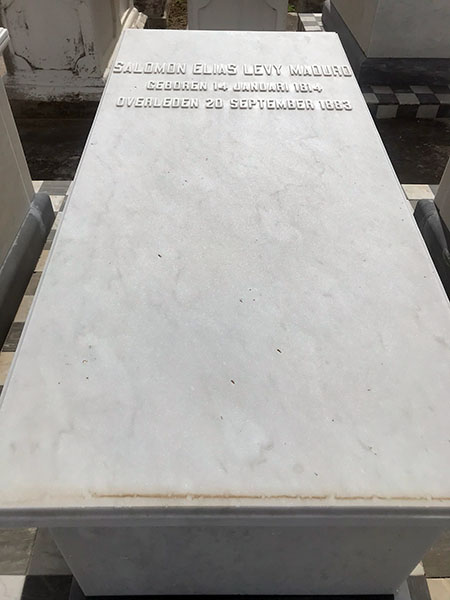
Salomon Elias Levy Maduro, known as Shon Monchi, began his first enterprise in 1837 with a modest store in the Heerestraat in downtown Punda. His first sales consisted of a shipment of some consumer items to St. Thomas. After a few years he acquired several schooners and revved up his shipping activities. By the early 1850s, his business had grown significantly, and he had become a respected businessman in town. In 1860, he was one of the four signers of a letter that started the process of enlarging the city of Willemstad by tearing down some of the walls surrounding the city and developing the area called Scharloo. The expansion resulted in new docking possibilities, an important element for the continued growth of what was by then called S.E.L. Maduro & Sons. Shon Monchi had five sons, who all joined him in the business. Before long, the company was building and repairing ships, supplying coal to the steamships docking in Curaçao, and continuing to expand in lateral businesses. Through the twentieth century, under the leadership of Shon Monchi’s sons and grandsons, there was no aspect of trading that was not touched by S.E.L. Maduro & Sons as participants and/or as facilitators of the infrastructure needed to stimulate the shipping business. The company still operates in Curaçao under management of the fifth generation descending from Shon Monchi


Tombstone Location: E-1
1920-2016
Ena Dankmeijer-Maduro
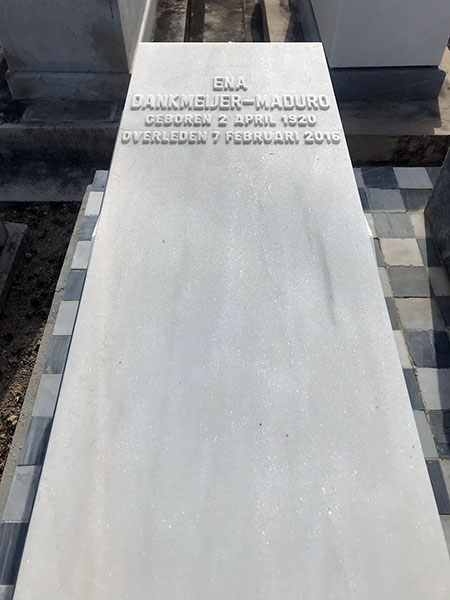
After viewing the resting places of some who died so young, you see before you the tombstone of a woman who was given a long and full life and used it to truly make a difference to this island. Ena Dankmijer was the driving force behind the Mongui Maduro Library that she founded together with her mother Louise Maduro-Brandao. The library offers a collection of Jewish and Antillean documents and literature and also houses the more than three and a half century-old archives of the Mikvé Israel – Emanuel Jewish community in a physical environment which will preserve these papers. The Mongui Maduro Library is a resource not only for those living in Curaçao, but for scholars worldwide. Equally so, she preserved the Rooi Catootje Great House as it was used for living in the 19th century and kept a large parcel of purposely green undeveloped land. For her dedication to building up this library and her investment in ensuring that it would be a respected institution beyond her own life, Ena was honored with a Royal Decoration and awarded the Silver Carnation from the Prins Bernhard Culture Fund. Shortly after her 90th birthday, she travelled to the Netherlands to receive this important recognition of a life well-lived.


Tombstone Location: ll-15
1844-1906
David Haim Salas
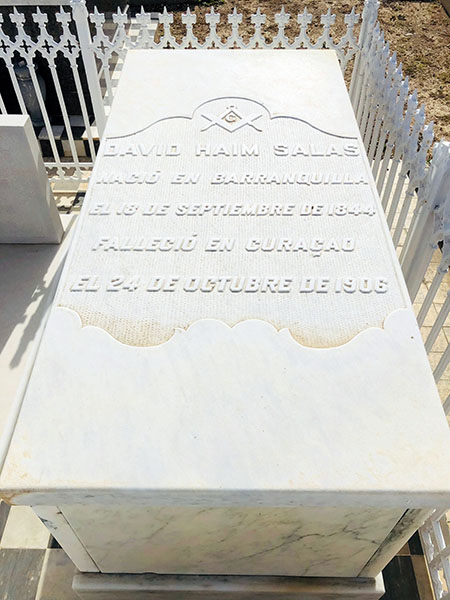
David Haim Salas was born in Barranquilla, Colombia, where his Curaçaoan parents lived for some years. In the 1850s his family moved back to Curaçao. As may be noted on his tombstone, David Haim Salas was a dedicated Freemason, as were many other Jews on the island. He was married to Rebecca Abinun de Lima in 1882, a wedding at which his father officiated. (The elder Salas served as cantor and led religious services at Temple Emanu-El for many years.) The couple had ten children. David was a businessman and traded with Latin America. At some point a ship that he owned rescued, at his instructions, a large number of shipwrecked sailors of an American schooner, the Cohannet, which sank off the coast of Venezuela. He received a commemorative silver bowl and a commendation from the U.S. State Department for these actions. Rebecca and David Salas’s tombstones are also interesting, because between them lie the remains of their son Julio Salas who died in Panama in 1961 and wished to be buried in Curaçao between his parents. Julio Salas’s wife, Clara Mendes Chumaceiro, was interred four years later in Panama.


Tombstone Location: h-35
Otto Senior was an entrepreneur. In 1931, he married Rosalynde Salas, the youngest daughter of Rebecca Abinun de Lima and David Haim Salas (H-35), and a few years later, in 1938, he and his wife founded the Ritz Ice Cream factory. The factory, located originally at the Heerenstraat in downtown Punda, also produced milk for the U.S. soldiers stationed in Curaçao during the Second World War. Soon a soda fountain was opened as well in the Breedestraat, Punda. And in 1947 the company expanded to a factory in Scharloo. By the 1960s this factory had become a top of the line dairy facility and its products were sold in all supermarkets on the island and from ice-cream trucks and the famous ice-cream carts that were peddled across the island. Otto Senior was president of the Mikvé Israel community at the time of the merger with Temple Emanu-El and was the motor behind the building of the three-story building adjoining the patio of the synagogue, in which are housed the Sala Consistorial as well as an archival area on the first floor. For several years also, other floors of this building were rented out thus providing a source of income to the Congregation.


Tombstone Location: LL-45
August 12, 1901
Dr. Salomon Mozes Lansberg
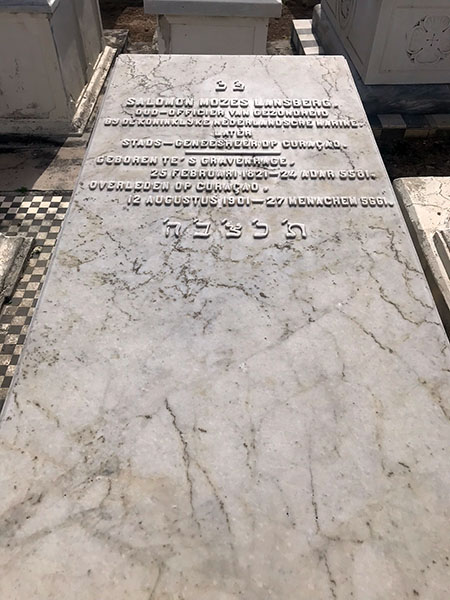
Salomon Mozes Lansberg was born in The Hague, the Netherlands. One of the few Ashkenazim in Curaçao at the end of the 19th century, he was a military physician of the Royal Dutch Navy. In 1858, he married Esther Cohen Henriquez of the Sephardic community and opened his medical practice in Curaçao. In the 1890s he also served as City Physician, a task he executed with “extraordinary zeal” according to the Colonial Council. In spite of the fact that almost all members of his wife’s Cohen Henriquez family were key parishioners of Temple Emanu-El, Dr. Lansberg remained a loyal member of the Mikvé Israel community and both he and his wife were buried in the Mikvé Israel burial ground on Berg Altena.


Tombstone Location: e-34
Jozef Da Costa Gomes died in Paris on December 26, 1889. News of his demise was reported in the Home Journal of the Young Men’s Hebrew Association in Curaçao in January of 1890. It was, however, not until June 15, 1890 that Da Costa Gomez’s remains were laid to rest in the Berg Altena cemetery, almost 6 months after he died, under this architecturally interesting monument. He was fifty years old at the time of his death and appears to have been single. It is not known what he was doing in Paris, but his mother was still alive when his life ended prematurely. Joseph was one of eight children in his family. It is most likely that some of his siblings, together with his mother, erected this impressive monument to his memory.


Tombstone Location: D-9
Prospero Moron was a man who was aware of the opportunities that came with modernization. He owned the first movie theater in Curaçao. At first silent movies were shown, but soon talkies also became available. American as well as European movies became a wonderful source of entertainment on the island. Sometimes the celluloid films would burn due to the heat of the projector lamp, and the screen would flare up with light. And then the theater would go dark as Moron frantically tried to splice and tape the film. At such times, the audience would start clapping and stamping their feet and would clamor “Shon Popo!” – his nickname – until he had fixed the problem and restarted the show. In spite of such problems, the movie theatre industry was a hit in Curaçao.


Tombstone Location: d-40
Lio Capriles often said he had three equally strong passions: his family, his Jewish religion, and his island of birth, Curaçao. Those who know him would undoubtedly add “his bank” as a fourth passion. He was a banker par excellence and one of his country’s principal capitalists, yet he was proud to be referred to sometimes as a socialist: he was continuously mindful of the fate of the less fortunate in his society. He had founded or directed numerous social, economic, sport and other organizations in Curaçao, and in each one took initiatives to benefit his country and its people. Under his leadership the Maduro & Curiel’s Bank expanded to all islands of the Dutch Caribbean and was the largest financial institution and private employer on these islands. He was rewarded in life by countless awards, honors, and decorations by several countries. He was not a most observant Jew, but he cared deeply for his Judaism – and was always ready to lend a hand, volunteer a donation, or offer a suggestion to enhance the Jewish experience in his synagogue and Jewish community. He was an avid reader of local and international newspapers and of books of all kinds, his own preference being non-fiction and biographies. He entitled a compendium of his speeches “M’a purba”, “I tried”, showing both his drive and his regret of not always having been able to improve the fate of his fellowman. One of his favorite expressions was “a turtle makes progress only when it sticks its neck out”, and he was used to stick out his neck publicly for what he believed in, even if he knew it would land him in hot water. And then there is the “Paps” that is also inscribed on his tomb. It was his favorite name for male acquaintances. When asked why he called so many persons “Paps” his answer was: “You can’t possibly expect me to remember everyone’s name.” For most of his adult life, Lio Capriles was the most popular, most loved, and most respected person in his country, an honor he respected greatly.


Tombstone Location: ll-27
Joseph Alvarez Correa was best known as Jojo or Shon Jojo. He was a scion of a distinguished Spanish & Portuguese Sephardic family that settled here from Amsterdam in 1675. His father and brother had founded a trading firm which was active in import and re-export of produce from Colombia and Venezuela and domestic trade in Curaçao, a firm that Jojo was running by the time he was 26. He married one of the granddaughters of Salomon Elias Levy Maduro, the founder of the then rapidly expanding firm of S.E.L. Maduro & Sons. In 1916 Jojo proposed to his brother in law, Salomon Mordechay Levy Maduro, that together they establish a commercial and money circulating bank in Curaçao. Already in December 1916 the Governor issued the required Governmental Decree, and on paper Maduro’s Bank, the first private commercial bank in the Dutch Caribbean, became a reality. In the 1930’s, Maduro’s Bank would merge with another local bank owned by Sephardic Jews, Curiel’s Bank, creating Maduro & Curiel’s Bank NV, the largest commercial bank on the Dutch Caribbean and a flagship of the Sephardic Jewish commercial presence in Curaçao. Jojo was a visionary entrepreneur with an optimistic outlook on life, He possessed a keen business sense, was highly intelligent and self-confident, but despite all that, he was decidedly modest, a taciturn man who rarely wasted any words. He was frequently consulted in an informal capacity by both the Curaçao and the Dutch governments and engaged in several cultural social and financial entities on the island. Widely respected in the Jewish community, Jojo would rarely be seen in religious services. When the then still quarreling Orthodox Mikvé Israel and Reform Emanu-El needed someone to help bring about a reconciliation, however, that successful meeting took place in 1932 in the home of Joseph Alvarez Correa.


Tombstone Location: ee-2


After World War I, Dr. Julius Benesch, who had been born in Austria, decided to leave his place of birth. Exactly how he ended up in Curaçao is not clear, but from 1922 to 1925 he was a government physician on the island. Subsequently he was off island for about a decade and returned in 1938 to open a private medical practice as a general practitioner. When the Netherlands were invaded by Germany on May 10, 1940, the colonial government on the Dutch islands ordered all German and Austrian citizens to be detained and deported to an internment camp on the island of Bonaire. This included Germans and Austrians of the Jewish faith. And so Dr. Benesch and his wife Mela, as well as other members of the Ashkenazi community, including the well-known photographer Fred Fischer (MM-18), found themselves living in close quarters on the neighboring island with several sympathizers of the Hitler regime. An untenable situation! Later that year the interned Jews were placed on a separate plantation in Bonaire. Only through the help of Rabbi Isaac Jessurun Cardozo of Curaçao’s Mikvé Israel community, who brought this absurd action to light by writing to international organizations such as the American Jewish Joint Distribution Committee and the World Jewish Congress, were the Jewish interns finally released. But they were required to report daily and subjected to a curfew. It was not until March 1944 that the restrictions imposed on these Austrian and German Jews were repealed. Yet, Dr. Benesch and many of the others who had been detained returned to Curaçao. Here Dr. Benesch built a successful medical practice and was the trusted general practitioner (“huisdokter”) of Jews and non-Jews alike.


Tombstone Location: AA-16
Julius Lopez Penha was born in St. Thomas, Virgin Islands, where his Curaçoan parents lived for a while when that island’s economy was on the upswing. In Curaçao, he became known as an erudite man, who later in life owned a huge library which was open to his friends and their offspring. He experimented with the culture of European fruit trees and cattle-raising on his plantations. He married Esther Naar, daughter of the wealthy Jacob J. Naar and eventually ran the business known today as J.L. Penha and Sons. That business is still owned and managed by his descendants and located in the iconic Penha building built in 1708 in downtown Punda for the then governor of Curaçao, right at the foot of the famous floating Emma Bridge at the harbor’s entrance. The epitaph includes the letters GR, three dots arranged in a triangle, and the number 33. This reflects that he had been bestowed the honorary 33rd Masonic Degree for meritorious service to craft masonry.


Tombstone Location: TE-6
Rebecca Cohen Henriquez was, as stated on her tombstone, knighted by Queen Wilhelmina of the Netherlands and honored with the decoration of Officer in the order of Simon Bolivar by Venezuela for founding and serving as president of Club Entre Nous. The Club Entre Nous was a benevolent society that raised most of its funds by giving theatrical performances. These monies were used to establish the Wilhelmina Park in downtown Punda and to distribute food packages to needy families in Curaçao. Rebecca’s tomb is one of a row of seven similar tombs of the Cohen Henriquez family.


Tombstone Location: TE-13
Sol. Cohen Henriquez was attorney general of Curaçao for many years and second in rank to the governor. During an absence from Curaçao by the governor in 1890, he served as acting governor. He was decorated with the highest orders extended to civilians in the Kingdom of the Netherlands: Commander of the order of Oranje Nassau and Officer of the Nederlandse Leeuw. Sol Cohen Henriquez was instrumental in the establishment of the Reform Temple Emanu-El and helped draw up its constitution. He was the father of the energetic and charitable Rebecca Cohen Henriquez (TE-13), who is buried nearby and whose tombstone mimics her father’s in style.


Tombstone Location: TE-16
This imposing tombstone belongs to Jacob Jeosuah Naar. As indicated in the Dutch text on this tombstone, Naar was Commander of the National Guard in Curaçao. The sword, hat and epaulettes worn by the Commander are depicted on this elaborate structure. Jacob J. Naar was a wealthy man who married an even wealthier woman, Abigail Cohen Henriquez. Abigail had brought a dowry of close to 48,000 florins to the marriage and they had seven children. Naar owned four large plantations as well as a very profitable snuff factory. Upon his death, the family displayed their wealth and love for the deceased by honoring him with this most impressive monument which adjoins several other elaborately sculpted tombs of his wife’s Cohen Henriquez family. Note that these Cohen Henriquez’, similar to the tombs of Sol and Rebecca, are also of similar design and ornaments, while the immediate family is grouped together.


Tombstone Location: Tf-22
This unusual tombstone with a bust of Manases Capriles stands out even in this cemetery with its many sculptures. It is the only one that has a depiction of the deceased and was sculpted in 1895 in Genoa, Italy. Manases Capriles had migrated from Curaçao to Coro, Venezuela as a young man and was an entrepreneur. He became involved in the manufacture of soap, and later also produced hides, candles, and castor oil. Eventually he sold his manufacturing concerns and invested in the short-lived Coro – La Vela Railroad, hoping it would increase business for the region. Although he died in Coro, his remains were brought back to his island of birth to be buried here. He is one of the few members of the Capriles family to secede from Mikvé Israel at the time of the schism and as such was interred in the area that was Temple Emanu-El’s burial ground.


Tombstone Location: TE-21
Moises Frois Ricardo was the itinerant mohel (circumciser) of the Caribbean. He left behind a journal of one hundred ninety-nine (199) circumcisions performed in Curaçao, Jamaica, Dominican Republic, Venezuela, and Colombia from 1840 to 1878. He was a member of the National Guard in Curaçao and had to request permission to leave the island each time his circumcision services were required in other parts of the Caribbean. He retired in 1860 with the rank of Captain but continued to perform the circumcision rites for many years thereafter. Frois Ricardo was a religious and learned man and took his responsibilities very seriously. He was the son of Mordechay Ricardo, who in 1814 had housed the sisters of Simon Bolivar in his mother-in-law’s country home called Octagon. The Octagon building, situated at the back of the Avila Beach Hotel, now has a museum recalling this gesture of friendship. Ricardo’s grave is unique as the epitaph is on a rectangular slab of concrete placed on top of the usual tomb.


Tombstone Location: Tc-24
This tombstone of Benjamin Gomes Cásseres, one of Ten Gomes Casseres Brothers, serves to show that sometimes mistakes were made even on these expensive marble slabs which were usually ordered from overseas. As can be seen, the name was spelled Cássereres instead of Cásseres. One must assume that it would have been too difficult to return this tombstone and request another one, and apparently nobody in Curaçao was able to remove the extra letters and fix this memorial to Benjamin Gomes Cásseres.


Tombstone Location: Tc-26
In addition to being a large and elaborate structure erected over the remains of several members of the Senior family, this tombstone is a lesson in the history of Curaçao’s Sephardim. After Venezuelan independence, Jews were welcomed to settle in that turbulent country. Among the early Curaçaoan Jews to try their fortune in Coro, Venezuela were members of the Senior family. Josias Lopez Senior (1862-1918,) who heads the list of names shown on this tombstone, was the grandson of one of these original immigrants to Coro. The Seniors managed to have great success in business in Venezuela, and from a young age Josias ran the firm “Isaac Senior e Hijos” that was started by his father. Interestingly, Curaçao remained the home of these Seniors up to three generations after the first member of the family settled in Coro. Even when they would die away from the island, their remains were brought back to the mother community. And so Josias, who died in Switzerland, his wife Sara who died in Coro, and their son Isaac (Ivan) who died in England were all buried in Curaçao’s Berg Altena cemetery, as were Josias’s father and grandfather. Coro was their business home – Curaçao was the home of their souls.


Tombstone Location: k-5,6,7
Irene Moreno spent much of her life organizing events of various kinds, raising money for the less fortunate, and inspiring others to do the same. She married Ivan Moreno in her early twenties and they had four children. But raising them was not the only thing Irene was to do. At the Curaçaosche Sports Club (CSC), founded by her father, she ran sports events, coached basketball teams, arranged ping-pong tournaments, and served on the board of the Club. Beyond those club activities, she sang in the synagogue choir, raised funds for the Curaçao Lions Club and many other foundations, and founded a Home for the Elderly. One could be sure to be sold a lottery ticket or be solicited for a donation for one of her favorite charities on many occasions – and she would never take no for an answer. In these ways, she greatly enriched the Jewish community and the community at large. In recognition of all Irene Moreno had meant for the Curaçao society, she was knighted by Queen Beatrix of the Netherlands.


Tombstone Location: RR-20
The inscription on this tombstone “Honored in Life – Remembered with Tender Love” is most appropriate for this self-made man who was born in Cuba where his Curaçaoan parents participated in the sugar boom of the early part of the twentieth century. Charlie, as he was known, came to Curaçao only eight years of age when his parents left Cuba, completed his schooling here, and proceeded to work, first in the family retail store, then at the firm of Edwards Henriquez & Co, and ending his business career at Maduro & Curiel’s Bank. He served as president of Temple Emanu-El, Mikvé Israel-Emanuel and the Jewish Cultural Historical Museum as well as on the boards of many business and social organizations and semi-public entities. Within the Jewish community, he remains best known as the knowledgeable historian of Curaçao’s Sephardim with many articles to his name. Together with Otto Senior (LL-45) and Rabbi Simeon J. Maslin, he was also a motor behind the merger of the two Sephardic congregations in Curaçao. Additionally, he published two books in Dutch, entitled “Bewoond Scharloo” and “Punda, Punda,” in which he recalled in charming detail life in Curaçao in the 1930s and 1940s. He was honored by the Royal House of the Netherlands with the distinguished orders of Officier Oranje Nassau and Ridder Nederlandse Leeuw, awarded the Silver Carnation of the Prins Bernhard Cultuur Fonds and also received many commendations from numerous other organizations in which he played an instrumental role.


Tombstone Location: ta-61
These two pillars mark the burial places of Dr. Salomon de Leon and his wife Sarah. Dr. De Leon was (one of) the first person(s) to be buried in the Berg Altena cemetery. His tombstone and those immediately around it are the oldest ones in this burial plot. His wife Sarah survived him by 35 years. When the doctor passed away at the young age of 41, she enlisted the help of her wealthy and learned brother, Anjel Jesurun, to raise their only son, Daniel, who was a mere 12 years old when his father died. After studying in Hildesheim, Germany, Daniel settled in New York City. By 1890, he had become one of the leading figures in the socialist movement and industrial unionism in the USA. This was probably not quite what Uncle Anjel had had in mind for him, yet he excelled in his field and was considered a charismatic leader and brilliant speaker for early socialist causes in America.
Note: Next to this first burial place in the new Reform Emanu-El cemetery, there is a column marking the grave of a M.P. Brandao mentions a date of death of 1860, appearing thus to be five years before this “first burial”. Based on information available of M.P. Brandao’s family, however, it is most likely that he lived and passed away in Colombia, and that after an initial interment there, his remains had been brought to Curaçao to be buried in the island of his forefathers.


Tombstone Location: ta-33
These two pillars mark the burial places of Dr. Salomon de Leon and his wife Sarah. Dr. De Leon was (one of) the first person(s) to be buried in the Berg Altena cemetery. His tombstone and those immediately around it are the oldest ones in this burial plot. His wife Sarah survived him by 35 years. When the doctor passed away at the young age of 41, she enlisted the help of her wealthy and learned brother, Anjel Jesurun, to raise their only son, Daniel, who was a mere 12 years old when his father died. After studying in Hildesheim, Germany, Daniel settled in New York City. By 1890, he had become one of the leading figures in the socialist movement and industrial unionism in the USA. This was probably not quite what Uncle Anjel had had in mind for him, yet he excelled in his field and was considered a charismatic leader and brilliant speaker for early socialist causes in America.
Note: Next to this first burial place in the new Reform Emanu-El cemetery, there is a column marking the grave of a M.P. Brandao mentions a date of death of 1860, appearing thus to be five years before this “first burial”. Based on information available of M.P. Brandao’s family, however, it is most likely that he lived and passed away in Colombia, and that after an initial interment there, his remains had been brought to Curaçao to be buried in the island of his forefathers.


Tombstone Location: ta-33
One of seven siblings, this young girl died at the tender age of twelve and was immortalized with this beautiful and unusual monument. Note on the back side of the grave a marble plaque with chopped off tree branch, unable to reach its full growth, reflecting her premature death. Most young children were buried in less elaborate, small plots as seen on both sides of the Casa de Rodeo and near the walls of the erstwhile Reform section of the cemetery.


Tombstone Location: a-25
Abraham Mendes Chumaceiro was a lawyer who cared deeply for the people of Curaçao. He became quite well known in his profession and even more so for his activist writings. In one of his most progressive essays, he expressed the desire for universal suffrage, opposing those who believed that the population of African descent was inferior and should not be given the vote. His eloquent article on this topic was provocatively entitled “Zal het kiesrecht Curaçao tot het Kannibalisme Voeren” (“Will universal suffrage lead Curaçao to Cannibalism?”.) Also, his book “Is Curaçao te Koop” (“Is Curaçao for Sale”?”), written in response to growing Dutch discontent with its colony and a clear interest on the part of Venezuela to take over the island, was widely lauded. At his tomb there is a special plaque which attests of the honor bestowed to him posthumously in 1938 by the first democratically elected parliament of the Dutch Antillean islands for all he had done to promote the cause of universal suffrage.


Tombstone Location: c-22
1881-1964
Joshua (Jossy) M. L. Maduro

Joshua M.L. Maduro (or Jossy as he was more commonly called) was a grandson of the founder of S.E.L. Maduro & Sons, Salomon Elias Levy Maduro (E-1), and had married his first cousin, Rebeccca, who was a granddaughter of Salomon Maduro. When his father died, Jossy Maduro became part of the top management of S.E.L. Maduro & Sons. It was assumed that his only son, George, would most likely follow in his father’s footsteps and run the company in the next generation. In order to give young George what Jossy considered the best possible training, he was sent to a private school in the Netherlands at an early age. After his secondary schooling, he studied law at the University of Leiden. But with the start of World War II, the university was closed. When the Germans invaded the Netherlands, George, who was a reserve officer in the Dutch military, acted heroically, and was posthumously given the highest military decoration ever given to an Antillean, the “Militaire Willemsorde.” He was captured twice by the Germans and let go, but the third time, as he was trying to escape the war zone, he was sent to Dachau where he died of typhus in February 1945. George’s death devastated his parents. Over the years, Jossy Maduro had become an amateur historian. He traced family trees for many Curaçaoan families and collected data and documents about the Sephardim of Curaçao. With George’s demise, Jossy retired from the family business and gave up his plans to write a complete history of the Jews of Curaçao. A plaque commemorating George J.L. Maduro may be seen near his parents’ tombstones. In memory of their beloved son, his parents also founded Madurodam, a small city full of Dutch miniatures, on the outskirts of The Hague. Jossy Maduro received decorations from many countries, including the Netherlands, Venezuela, France, Sweden, Cuba, and Chile. No medals, however, could, ever replace the loss of his son.


Tombstone Location: QQ-4
1814-1883
Salomon Elias Levy Maduro

Salomon Elias Levy Maduro, known as Shon Monchi, began his first enterprise in 1837 with a modest store in the Heerestraat in downtown Punda. His first sales consisted of a shipment of some consumer items to St. Thomas. After a few years he acquired several schooners and revved up his shipping activities. By the early 1850s, his business had grown significantly, and he had become a respected businessman in town. In 1860, he was one of the four signers of a letter that started the process of enlarging the city of Willemstad by tearing down some of the walls surrounding the city and developing the area called Scharloo. The expansion resulted in new docking possibilities, an important element for the continued growth of what was by then called S.E.L. Maduro & Sons. Shon Monchi had five sons, who all joined him in the business. Before long, the company was building and repairing ships, supplying coal to the steamships docking in Curaçao, and continuing to expand in lateral businesses. Through the twentieth century, under the leadership of Shon Monchi’s sons and grandsons, there was no aspect of trading that was not touched by S.E.L. Maduro & Sons as participants and/or as facilitators of the infrastructure needed to stimulate the shipping business. The company still operates in Curaçao under management of the fifth generation descending from Shon Monchi


Tombstone Location: E-1
1920-2016
Ena Dankmeijer-Maduro

After viewing the resting places of some who died so young, you see before you the tombstone of a woman who was given a long and full life and used it to truly make a difference to this island. Ena Dankmijer was the driving force behind the Mongui Maduro Library that she founded together with her mother Louise Maduro-Brandao. The library offers a collection of Jewish and Antillean documents and literature and also houses the more than three and a half century-old archives of the Mikvé Israel – Emanuel Jewish community in a physical environment which will preserve these papers. The Mongui Maduro Library is a resource not only for those living in Curaçao, but for scholars worldwide. Equally so, she preserved the Rooi Catootje Great House as it was used for living in the 19th century and kept a large parcel of purposely green undeveloped land. For her dedication to building up this library and her investment in ensuring that it would be a respected institution beyond her own life, Ena was honored with a Royal Decoration and awarded the Silver Carnation from the Prins Bernhard Culture Fund. Shortly after her 90th birthday, she travelled to the Netherlands to receive this important recognition of a life well-lived.


Tombstone Location: ll-15
1844-1906
David Haim Salas

David Haim Salas was born in Barranquilla, Colombia, where his Curaçaoan parents lived for some years. In the 1850s his family moved back to Curaçao. As may be noted on his tombstone, David Haim Salas was a dedicated Freemason, as were many other Jews on the island. He was married to Rebecca Abinun de Lima in 1882, a wedding at which his father officiated. (The elder Salas served as cantor and led religious services at Temple Emanu-El for many years.) The couple had ten children. David was a businessman and traded with Latin America. At some point a ship that he owned rescued, at his instructions, a large number of shipwrecked sailors of an American schooner, the Cohannet, which sank off the coast of Venezuela. He received a commemorative silver bowl and a commendation from the U.S. State Department for these actions. Rebecca and David Salas’s tombstones are also interesting, because between them lie the remains of their son Julio Salas who died in Panama in 1961 and wished to be buried in Curaçao between his parents. Julio Salas’s wife, Clara Mendes Chumaceiro, was interred four years later in Panama.


Tombstone Location: h-35
Otto Senior was an entrepreneur. In 1931, he married Rosalynde Salas, the youngest daughter of Rebecca Abinun de Lima and David Haim Salas (H-35), and a few years later, in 1938, he and his wife founded the Ritz Ice Cream factory. The factory, located originally at the Heerenstraat in downtown Punda, also produced milk for the U.S. soldiers stationed in Curaçao during the Second World War. Soon a soda fountain was opened as well in the Breedestraat, Punda. And in 1947 the company expanded to a factory in Scharloo. By the 1960s this factory had become a top of the line dairy facility and its products were sold in all supermarkets on the island and from ice-cream trucks and the famous ice-cream carts that were peddled across the island. Otto Senior was president of the Mikvé Israel community at the time of the merger with Temple Emanu-El and was the motor behind the building of the three-story building adjoining the patio of the synagogue, in which are housed the Sala Consistorial as well as an archival area on the first floor. For several years also, other floors of this building were rented out thus providing a source of income to the Congregation.


Tombstone Location: LL-45
August 12, 1901
Dr. Salomon Mozes Lansberg

Salomon Mozes Lansberg was born in The Hague, the Netherlands. One of the few Ashkenazim in Curaçao at the end of the 19th century, he was a military physician of the Royal Dutch Navy. In 1858, he married Esther Cohen Henriquez of the Sephardic community and opened his medical practice in Curaçao. In the 1890s he also served as City Physician, a task he executed with “extraordinary zeal” according to the Colonial Council. In spite of the fact that almost all members of his wife’s Cohen Henriquez family were key parishioners of Temple Emanu-El, Dr. Lansberg remained a loyal member of the Mikvé Israel community and both he and his wife were buried in the Mikvé Israel burial ground on Berg Altena.


Tombstone Location: e-34
Jozef Da Costa Gomes died in Paris on December 26, 1889. News of his demise was reported in the Home Journal of the Young Men’s Hebrew Association in Curaçao in January of 1890. It was, however, not until June 15, 1890 that Da Costa Gomez’s remains were laid to rest in the Berg Altena cemetery, almost 6 months after he died, under this architecturally interesting monument. He was fifty years old at the time of his death and appears to have been single. It is not known what he was doing in Paris, but his mother was still alive when his life ended prematurely. Joseph was one of eight children in his family. It is most likely that some of his siblings, together with his mother, erected this impressive monument to his memory.


Tombstone Location: D-9
Prospero Moron was a man who was aware of the opportunities that came with modernization. He owned the first movie theater in Curaçao. At first silent movies were shown, but soon talkies also became available. American as well as European movies became a wonderful source of entertainment on the island. Sometimes the celluloid films would burn due to the heat of the projector lamp, and the screen would flare up with light. And then the theater would go dark as Moron frantically tried to splice and tape the film. At such times, the audience would start clapping and stamping their feet and would clamor “Shon Popo!” – his nickname – until he had fixed the problem and restarted the show. In spite of such problems, the movie theatre industry was a hit in Curaçao.


Tombstone Location: d-40
Lio Capriles often said he had three equally strong passions: his family, his Jewish religion, and his island of birth, Curaçao. Those who know him would undoubtedly add “his bank” as a fourth passion. He was a banker par excellence and one of his country’s principal capitalists, yet he was proud to be referred to sometimes as a socialist: he was continuously mindful of the fate of the less fortunate in his society. He had founded or directed numerous social, economic, sport and other organizations in Curaçao, and in each one took initiatives to benefit his country and its people. Under his leadership the Maduro & Curiel’s Bank expanded to all islands of the Dutch Caribbean and was the largest financial institution and private employer on these islands. He was rewarded in life by countless awards, honors, and decorations by several countries. He was not a most observant Jew, but he cared deeply for his Judaism – and was always ready to lend a hand, volunteer a donation, or offer a suggestion to enhance the Jewish experience in his synagogue and Jewish community. He was an avid reader of local and international newspapers and of books of all kinds, his own preference being non-fiction and biographies. He entitled a compendium of his speeches “M’a purba”, “I tried”, showing both his drive and his regret of not always having been able to improve the fate of his fellowman. One of his favorite expressions was “a turtle makes progress only when it sticks its neck out”, and he was used to stick out his neck publicly for what he believed in, even if he knew it would land him in hot water. And then there is the “Paps” that is also inscribed on his tomb. It was his favorite name for male acquaintances. When asked why he called so many persons “Paps” his answer was: “You can’t possibly expect me to remember everyone’s name.” For most of his adult life, Lio Capriles was the most popular, most loved, and most respected person in his country, an honor he respected greatly.


Tombstone Location: ll-27
Joseph Alvarez Correa was best known as Jojo or Shon Jojo. He was a scion of a distinguished Spanish & Portuguese Sephardic family that settled here from Amsterdam in 1675. His father and brother had founded a trading firm which was active in import and re-export of produce from Colombia and Venezuela and domestic trade in Curaçao, a firm that Jojo was running by the time he was 26. He married one of the granddaughters of Salomon Elias Levy Maduro, the founder of the then rapidly expanding firm of S.E.L. Maduro & Sons. In 1916 Jojo proposed to his brother in law, Salomon Mordechay Levy Maduro, that together they establish a commercial and money circulating bank in Curaçao. Already in December 1916 the Governor issued the required Governmental Decree, and on paper Maduro’s Bank, the first private commercial bank in the Dutch Caribbean, became a reality. In the 1930’s, Maduro’s Bank would merge with another local bank owned by Sephardic Jews, Curiel’s Bank, creating Maduro & Curiel’s Bank NV, the largest commercial bank on the Dutch Caribbean and a flagship of the Sephardic Jewish commercial presence in Curaçao. Jojo was a visionary entrepreneur with an optimistic outlook on life, He possessed a keen business sense, was highly intelligent and self-confident, but despite all that, he was decidedly modest, a taciturn man who rarely wasted any words. He was frequently consulted in an informal capacity by both the Curaçao and the Dutch governments and engaged in several cultural social and financial entities on the island. Widely respected in the Jewish community, Jojo would rarely be seen in religious services. When the then still quarreling Orthodox Mikvé Israel and Reform Emanu-El needed someone to help bring about a reconciliation, however, that successful meeting took place in 1932 in the home of Joseph Alvarez Correa.


Tombstone Location: ee-2
